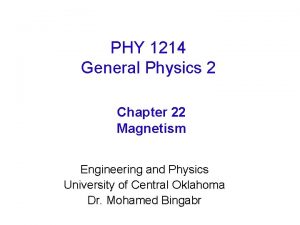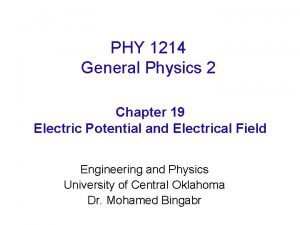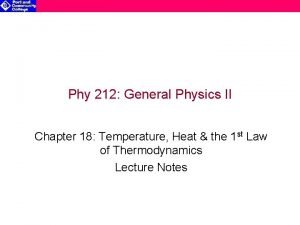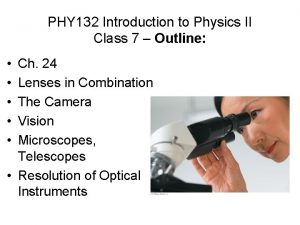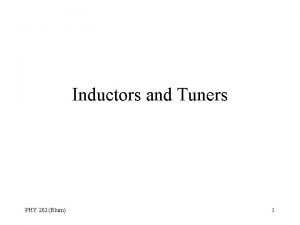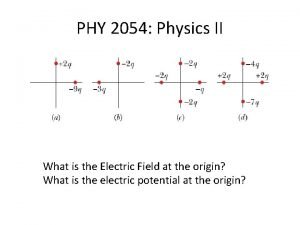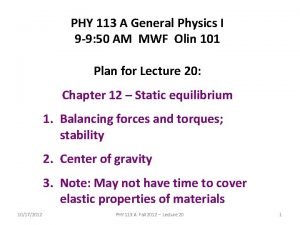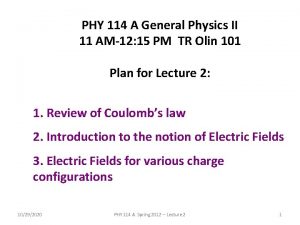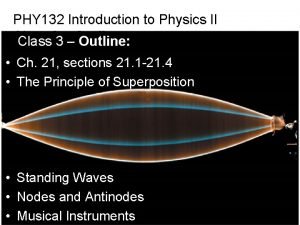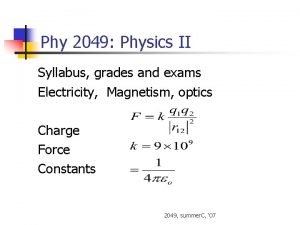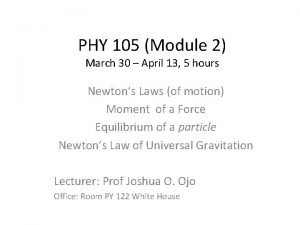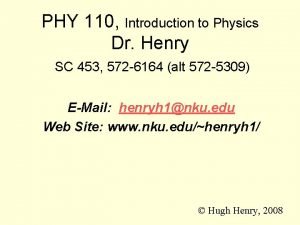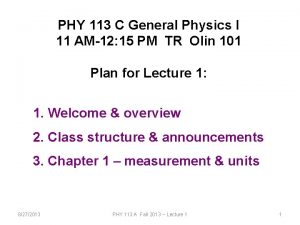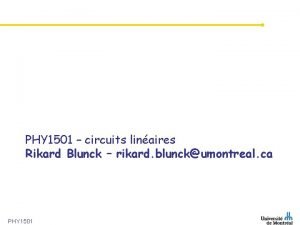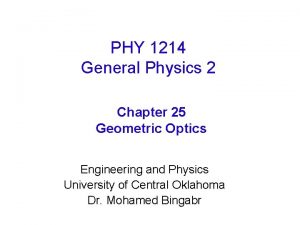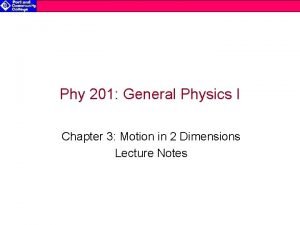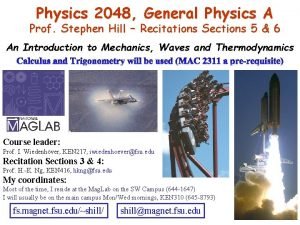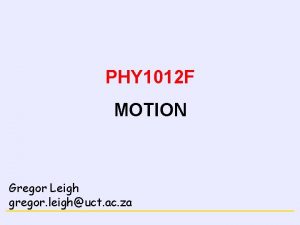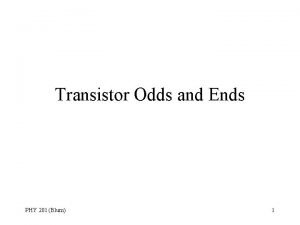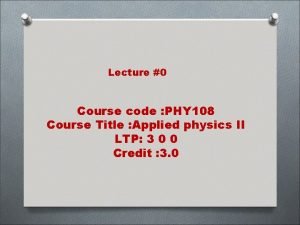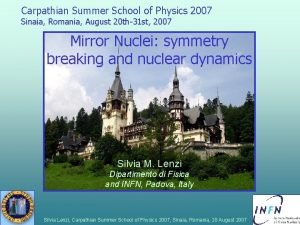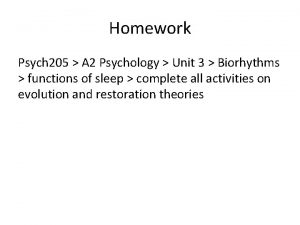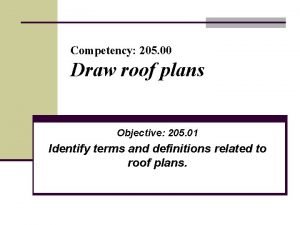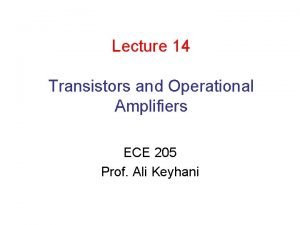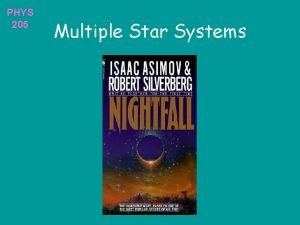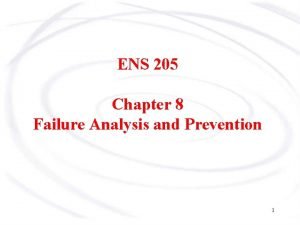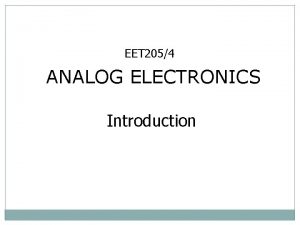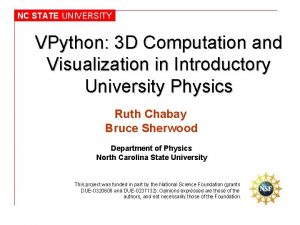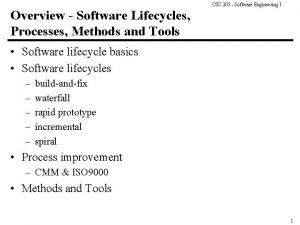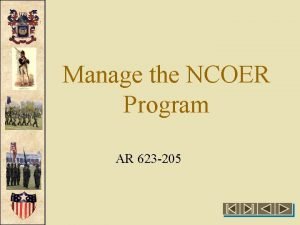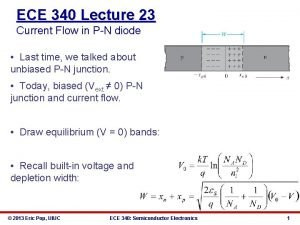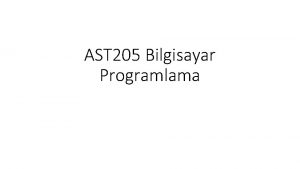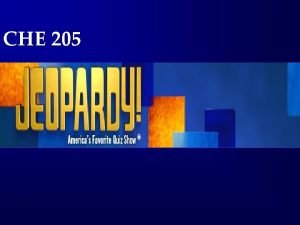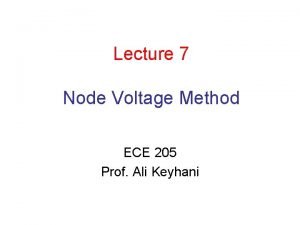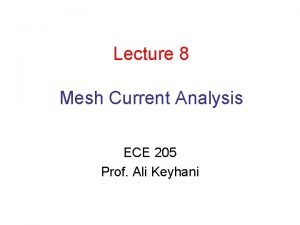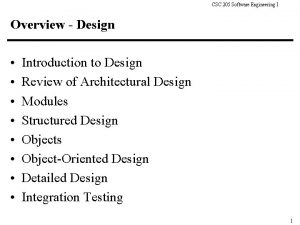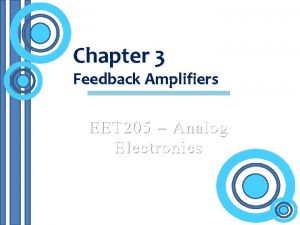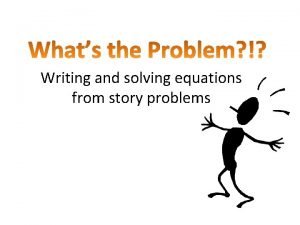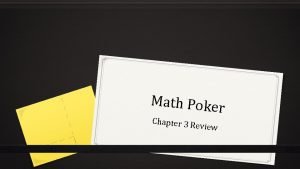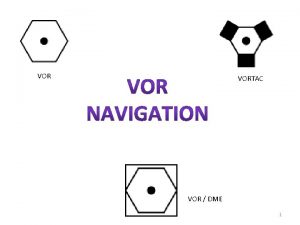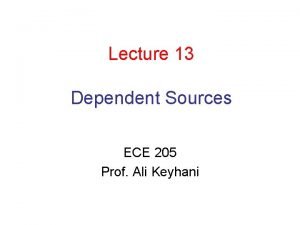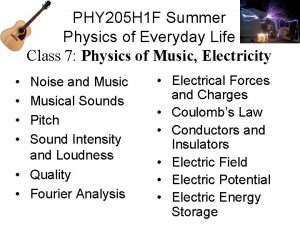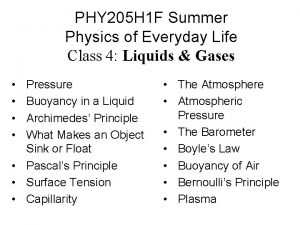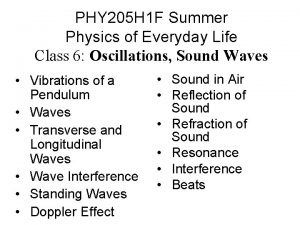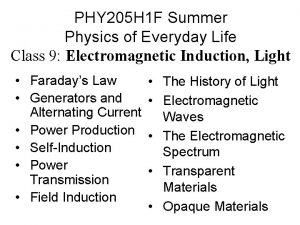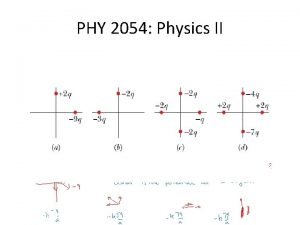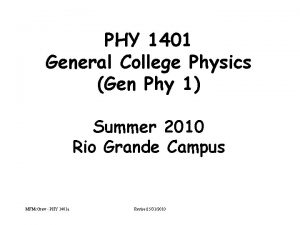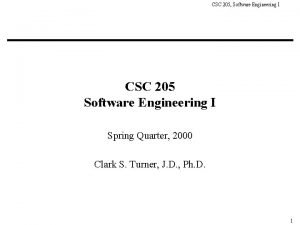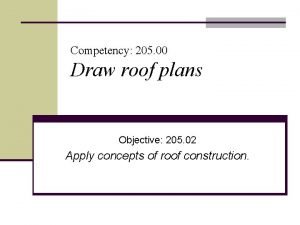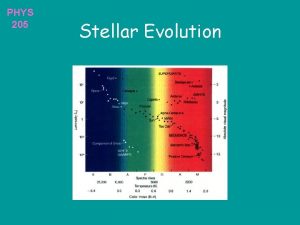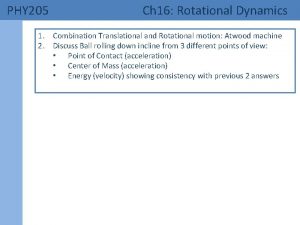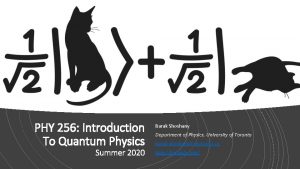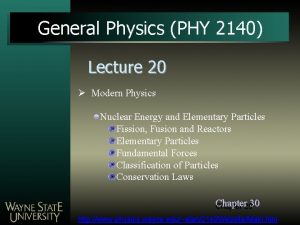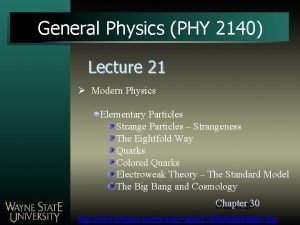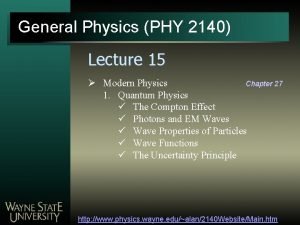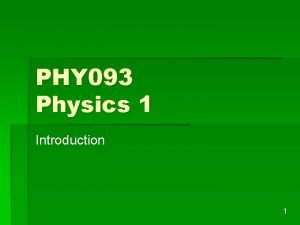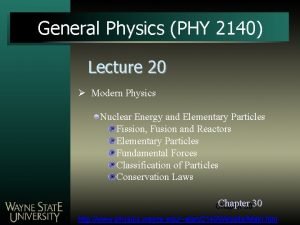PHY 205 H 1 F Summer Physics of



































































- Slides: 67

PHY 205 H 1 F Summer Physics of Everyday Life Class 8: Electric Current, Magnetism • Flow of Charge • Voltage, Current, Resistance • Ohm’s Law • DC and AC • Electric Power • Light bulbs • Electric Circuits • Magnetic Force • Electric Currents and Magnetic Fields • Magnetic Force on Current Carrying Wires • Earth’s Magnetic Field

Flow of Charge • When the ends of an electrical conductor are at different electric potentials—when there is a potential difference— flows from one end to the other. Electrical Conductor Motion of charge High Electric Potential Low Electric Potential

Electricity/Water Analogy: • Electric charge flows from potential to potential, if it can. Higher Potential Lower Potential • Water flows from pressure to pressure, if it can.

Continuing the Analogy… • To maintain a continuing flow of charge in a conductor, a must be provided to maintain the potential difference (=voltage). • To maintain a continuing flow of water in a pipe, a must be provided to maintain the pressure difference Battery

Electric Current is a Number • Electric current is the rate that from one point to another • The common symbol for current is I • The unit of current is per • 1 C/s = 1 Ampere = 1 Amp = 1 A [image from http: //people. oregonstate. edu/~ joneski/electric. htm ] moves (C/s)

Electric Current CHECK YOUR NEIGHBOR A capacitor begins with two neutral metal plates. A battery is attached and charges up the capacitor, so that 6 seconds later there is +3 Coulombs of charge on the positive plate, and -3 Coulombs of charge on the negative plate. What was the average current running through the battery as the capacitor was charging? A. B. C. D. E. Zero 0. 33 Amps 0. 5 Amps 1 Amp 2 Amps

Voltage is a Number • Electric potential difference is called “ ” • Voltage between two points causes electric current in a conductor flow from higher potential to lower potential. • No current flows when the voltage is zero • The unit of voltage is. • 1 Volt = 1 V = 1 Joule per Coulomb • We say that when voltage is set up across a conducting object, it can cause a current to flow through the conducting object. [image from http: //people. oregonstate. edu/~ joneski/electric. htm ]

Electric Current CHECK YOUR NEIGHBOR What does a good DC battery supply you with, such as this brand-new Duracell? A. A steady supply of current to put into a circuit. B. A steady rate of energy flow into a circuit. C. A constant voltage to apply across a circuit.

Electric Resistance Current in a circuit depends on: • voltage. • electrical resistance. Resistors are circuit elements that use up energy; usually they create. In a circuit diagram, the symbol for a resistor is:

Resistance is a Number • When you apply a across an object, the amount of depends on the object’s resistance. • Resistance of an object is measured in Ohms • 1 Ohm = 1 Ω = 1 Volt per Amp • The higher the resistance of an object, the less current will flow through it for a given voltage. [image from http: //people. oregonstate. edu/~ joneski/electric. htm ]

Electric Current CHECK YOUR NEIGHBOR A pump is pushing water through a narrow wiggly pipe, called a “line”. If you increase the length of the line, without changing the pressure of the pump, how will this affect the rate that water flows through it? A. The flow rate will decrease B. The flow rate will increase C. The flow rate will stay the same

Electric Current CHECK YOUR NEIGHBOR A pump is pushing water through a narrow wiggly pipe, called a “line”. If you increase the diameter of the line, without changing the pressure of the pump, how will this affect the rate that water flows through it? A. The flow rate will decrease B. The flow rate will increase C. The flow rate will stay the same

Electric Resistance • Factors affecting electrical object: 1. Material of an – Rubber is much more resistive than copper 2. Cross-sectional area – Thin wires have more resistance than thick wires 3. Length – An object twice as long has twice as much resistance.

Ohm’s Law • The current in a circuit varies in direct proportion to the potential difference, or voltage, and inversely with the resistance Current Examples: • For a constant resistance, current will be twice as much for twice the voltage. • For twice the resistance and twice the voltage, current will be unchanged.

Continuing the Analogy… • If you increase the pressure on the pump, water will flow through the line (analogous to increasing voltage) • If you keep the pressure the same, but make the line longer or narrower, water will flow through the line (analogous to increasing resistance)

Electric Current CHECK YOUR NEIGHBOR A battery is set up to push current through a resistor. The battery has a voltage of 100 V. The resistor has a resistance of 500 Ω. When you close the switch, what is the current flowing around the circuit? A. B. C. D. E. 0. 2 A 5 A 100 A 50, 000 A

You are a resistor!! • The human body has a , which depends on the exact path through your body, and whether your hands are wet or dry. • If your hands are moist, the resistance between them can be as low as 500 Ω • So if there is a voltage of 100 V between your hands, this will set up a current of 0. 2 A, straight through your heart! • Electrical current traveling through your body can tissue, and interfere with the beating of your heart (which is electrical) [image from http: //www. retronaut. com/2012/10/30 -ways-to-die-by-electrocution ]

Direct and Alternating Current • Direct current (dc) – Flows in one direction only. – Current always flows from the terminal toward the terminal. • Alternating Current (ac) – Current in the circuit flows first in one direction and then in the opposite direction, alternating to and fro many times per. – This is accomplished by alternating the polarity of voltage at the generator or other voltage source.

Direct and Alternating Current • Commercial electricity in North America is alternating current (ac): – cycles per second – Voltage is V • Power transmission is more efficient at higher voltages. – Europe and China adopted 220 V as their standard. – Canada and the U. S. continued with 120 V because so much equipment was already installed.

Electric Current CHECK YOUR NEIGHBOR When you turn on a light switch, A. An electric field is set up in along the wire, which immediately begins pushing electrons in the light. B. Electric current immediately begins flowing in the switch, which pushes electrons who bump into neighbouring electrons, all the way up to the light, like a sequence of dominoes. C. The switch sends a stream of electrons toward the light, which, when it reaches the light, makes the light go on.

Speed and Source of Electrons in a Metal Wire When we flip the light switch on a wall and the circuit, an electric field is established inside the conductor. • The electrons continue their random motions while simultaneously being nudged by the electric field. • Current is established through the wires at nearly the speed of light. • It is not the electrons that move at this speed. • It is the electric field that can travel through a circuit at nearly the speed of light.

Speed and Source of Electrons in a Circuit Misconceptions about electric current: “Current is propagated through the conducting wires by electrons bumping into one another. ” – NOT true: Electrons that are free to move in a conductor are accelerated by the impressed upon them. – True, they do bump into one another and other atoms, but this slows them down and offers resistance to their motion. – Electrons throughout the entire closed path of a circuit all react simultaneously to the electric field.

Electric Power • Power is the rate at which electric energy is used up in a circuit. • Power = • In units:

Check your neighbour • How much current is drawn by a 100 Watt light bulb, when used with a normal 120 Volt power supply? A. B. C. D. E. 0. 8 A 1. 2 A 100 A 12, 000 A

Electric Circuits • Connected in two common ways: – Series • forms a single pathway for electron flow between the terminals of the battery, generator, or wall outlet – Parallel • forms branches, each of which is a separate path for the flow of electrons

Series Circuits • Characteristics of circuits 1. Electric current through a single pathway. 2. Total resistance to current is the sum of individual resistances. 3. Current is equal to the voltage supplied by the source divided by the total resistance of the circuit.

Series Circuits • Characteristics of circuits 4. The sum of the voltage drops across the series resistors is equal to the total voltage supplied by the source. 5. The voltage drop across each device are proportional to its resistance. 6. If one device fails, current in the entire circuit ceases.

Electric Circuits CHECK YOUR NEIGHBOR When two identical lamps in a circuit are connected in series, the total resistance is A. B. C. less than the resistance of either lamp. the same as the resistance of each lamp. more than the resistance of either lamp.

Parallel Circuits • Characteristics of circuits 1. Voltage is the same across each device. 2. The total current in the circuit divides among the parallel branches. 3. The total current in the circuit equals the sum of the currents in its parallel branches.

Parallel Circuits • Characteristics of circuits 4. As the number of parallel branches is increased, the overall resistance of the circuit is decreased. 5. A break in one path does not interrupt the flow of charge in the other paths.

Electric Circuits CHECK YOUR NEIGHBOR When two identical lamps in a circuit are connected in parallel, the total resistance is A. B. C. less than the resistance of either lamp. the same as the resistance of each lamp. more than the resistance of either lamp.

Parallel Circuits • The more parallel resistors are added, the total resistance of the circuit, since there are more paths for the current to go through • If one path breaks, the current continues through the remaining paths

Magnetism Magnets are essential components of many devices used in everyday life.

The Electric Force • Any two charged particles exert an force upon each other, as determined by Coulomb’s Law. • This is true whether or not they are stationary or moving.

The Magnetic Force • If two charged particles are moving, they can exert a force on each other, in addition to the electric force. • A Magnetic field is created by a moving charged particle.

The Magnetic Force • This is the field surrounding a current loop. • Electric charge is moving in a tiny circular path, perpendicular to the screen.

Permanent Magnets • Every permanent magnet contains billions of tiny current loops which gives rise to the magnetic force. • We call one end of a permanent magnet “N” or North, and the other end of a permanent magnet “S” or South • The N and S are called magnetic – every magnet has both N S

The Magnetic Force • Opposite poles attract, like poles repel. N S S N S N N S

Magnetic Poles CHECK YOUR NEIGHBOR A weak and strong magnet repel each other. The greater repelling force is experienced by the A. B. C. D. stronger magnet. weaker magnet. Both the same. None of the above.

Magnetic Poles • If you break one magnet in half, you get two magnets, each with two poles again. N N S S N S • No single isolated magnetic monopole has been found to exist in nature. • Poles always come in N+S pairs like this.

Permanent Magnets • Magnets can come in many shapes • Every one has an N side and an S side. S S N N N S

Compass • A compass is a small bar that is free to rotate about a vertical axis • It aligns itself with the field • The needle shown floating on a cork below is a compass • It’s -side is the “arrow”, showing which way the compass points.

Does the compass needle rotate clockwise (cw), counterclockwise (ccw) or not at all? A. Clockwise B. Counterclockwise C. Not at all

N S Does the compass needle rotate clockwise (cw), counterclockwise (ccw) or not at all? A. Clockwise B. Counterclockwise C. Not at all

Compasses point in the direction of the magnetic field. S N [image from http: //twistedsifter. com/2012/05/visualizing-magnetic-fields-compasses-iron-filings/ ]

Magnetic Fields The direction of the magnetic field surrounding a bar magnet is from the pole to the pole. S N [image from http: //www. tutorvista. com/content/science-ii/magnetic-effects-electric-current/mapping-magnetic-lines. php ]

Earth’s Magnetic Field • Earth is itself a huge magnet. • The magnetic poles of Earth are widely separated from the geographic poles. • The magnetic field of Earth is due to electric in the molten interior. • Earth’s magnetic field reverses direction every several hundred thousand years

Magnetic Poles CHECK YOUR NEIGHBOR We know that the magnetic field of the earth is produced by electric currents in the molten core. The magnetic field of the earth can be modeled as if the earth contains a big bar-magnet. Knowing the direction compasses point, which way is this internal bar-magnet oriented? A N S B S N

S N

Magnetic Fields • Produced by two kinds of electron motion – Electron orbits – Electron spin • main contributor to magnetism • pair of electrons spinning in opposite direction cancels magnetic field of the other • unpaired electron spins give rise to net magnetic field of iron

Magnetic Fields CHECK YOUR NEIGHBOR A source of magnetism is A. B. C. D. electrons orbiting around an atomic nucleus. electrons spinning around internal axes. both A and B. None of the above

Ferromagnetism (Iron) Neighbouring Iron atoms like to have their electrons in the same direction.

Ferromagnetism (Iron) etic gn t e n g Ma in ma o D ic Ma Sometimes a border develops between two regions within the iron where the neighbours all have different electron spin directions. in ma Do

Magnetic Domains Clusters of aligned magnetic atoms are called magnetic domains Hitting a piece of iron with a hammer in a magnetic field can magnetize the iron by the magnetic domains.

Permanent Magnets

Magnetic Domains • In a Magnet, the alignment of domains remains once external magnetic field is removed • In a Temporary , the alignment of domains returns to random arrangement once external magnetic field is removed

Connection between electricity and magnetism • Magnetic field forms a pattern of concentric circles around a currentcarrying wire. • When current reverses direction, the direction of the field lines reverse.

Magnetic field intensity increases as the number of loops increases in a currentcarrying coil temporary magnet.

Electromagnets • A current-carrying coil of wire is an. • The strength of an electromagnet is increased by – increasing the current through the coil – increasing the number of turns in the coil – having a piece of iron within the coil. • Magnetic domains in the iron core are induced into alignment, adding to the field.

Magnetic Forces on Moving Charges The magnetic force on a charged particle is to the magnetic field and the particle’s velocity.

Magnetic Force on Moving Charges CHECK YOUR NEIGHBOR An electron moves down in a magnetic field. It experiences a magnetic force to the left, as shown. What is the direction of the magnetic field? A. Left or right B. Into the page or out of the page C. Up or down

Magnetic Force on Moving Charges CHECK YOUR NEIGHBOR The magnetic force on a moving charged particle can change the particle’s A. B. C. D. speed. direction. Both A and B. Neither A nor B.

Magnetic Force is important for fast moving electrons or positive ions in a vacuum. Since F tends to be perpendicular to v, it forms a good centripetal force.

Cyclotron Motion: in 3 D the motion of charged particles is not a circle but a. The Earth’s magnetic field protects us from high energy charged particles from the Sun (beta, alpha radiation).

Earth’s Magnetic Field • Space is filled with fast-moving charged particles called cosmic radiation. • This kind of radiation is harmful to plants and animals. • Cosmic radiation is deflected away from Earth by Earth’s magnetic field. • Some of the charged particles are trapped in the outer reaches of Earth’s magnetic field and make up the Van Allen radiation belts

Aurora Borealis is natural light caused by charged particles accelerating in the Earth’s magnetic field.

Before Class 9 on Monday • Please read Chapters 25 and 26, or at least watch the 20 -minute pre-class video for class 9 • Pre-class reading quiz on chapters 25 and 26 is due Monday June 17 by 10: 00 am • Something to think about: • Electric current can create a magnetic field. • Can a moving magnet create an electric field?
 Phy 205
Phy 205 Applications of magnetism
Applications of magnetism Phy113
Phy113 Phy 1214
Phy 1214 Phy 212
Phy 212 Phy 2049
Phy 2049 Nearsightedness physics
Nearsightedness physics Phy
Phy Great orthogonality theorem
Great orthogonality theorem Fizik ii
Fizik ii Phy tgen
Phy tgen Atm packet phy
Atm packet phy 2012 phy
2012 phy Phy 121 asu
Phy 121 asu Phy
Phy Phy
Phy Phy 132
Phy 132 Life phy
Life phy Phy 221 msu
Phy 221 msu Phy 2049
Phy 2049 Ddr phy architecture
Ddr phy architecture General physics measurement
General physics measurement Phy-105 5 discussion
Phy-105 5 discussion Phy 131 past papers
Phy 131 past papers Law of motion
Law of motion Phy
Phy Phy 1214
Phy 1214 Phy circuit
Phy circuit Phy theorem
Phy theorem General physics
General physics Nearsighted diverging lens
Nearsighted diverging lens Vx=vox+axt
Vx=vox+axt Loncapa fsu
Loncapa fsu Complete motion diagram
Complete motion diagram Phy 231 msu
Phy 231 msu Phy
Phy Phy108
Phy108 Carpathian summer school of physics
Carpathian summer school of physics Psych205
Psych205 Gable roof plan drawing
Gable roof plan drawing Ece 205
Ece 205 205 to binary
205 to binary Ens 205
Ens 205 Far91.205
Far91.205 Eet 205 syllabus
Eet 205 syllabus Vpython alternatives
Vpython alternatives Csc 205
Csc 205 A blue segmented circle on a sectional chart
A blue segmented circle on a sectional chart Far91.205
Far91.205 205 lafayette street newark nj
205 lafayette street newark nj Types of ncoers
Types of ncoers Qualitative description of current flow at a junction
Qualitative description of current flow at a junction Rounding to ten thousands
Rounding to ten thousands Ast 205
Ast 205 Che 205
Che 205 18 usc 205
18 usc 205 Eco 205
Eco 205 Item 205
Item 205 Ece 205
Ece 205 Ece 205
Ece 205 Define coupling in software engineering
Define coupling in software engineering Analog electronics
Analog electronics Ar for ncoer
Ar for ncoer A race car can travel at a rate of 205 miles per hour
A race car can travel at a rate of 205 miles per hour Tyler needs at least 205
Tyler needs at least 205 Vor vortac vor dme
Vor vortac vor dme Sia 205
Sia 205 Ece 205
Ece 205

